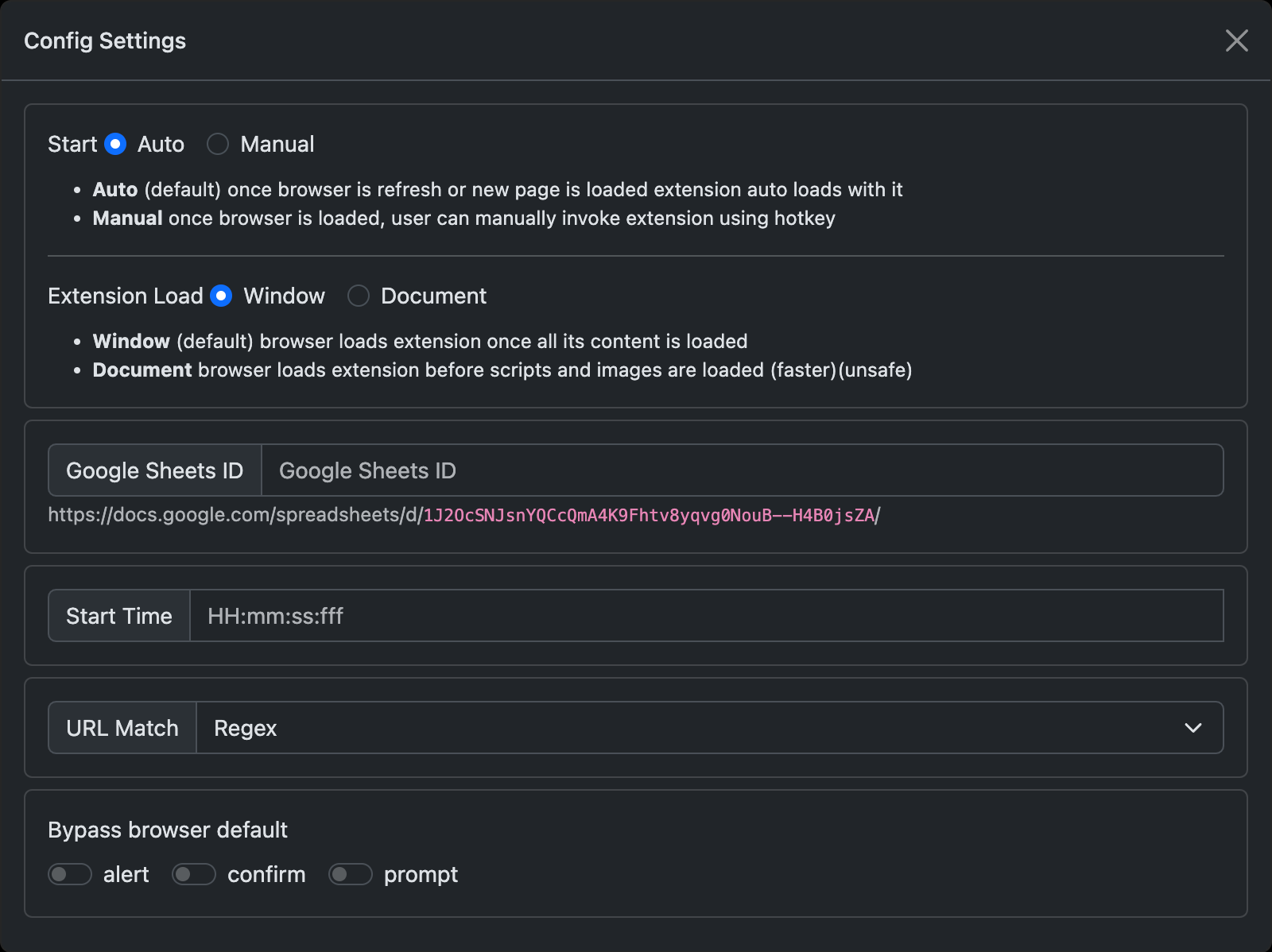Configuration Settings
Detailed explanation of key configuration settings and how to use them effectively.

Start [ Auto | Manual ]
Start the extension automatically or manually without refreshing the page.
- Enable Manual Start
- Refresh the target page once to switch between Auto and Manual modes
- Check the status bar to confirm Manual mode
- Press
Ctrl + Shift + Ato start the extension - You can change the hotkey in settings
Extension Load
| Event Type | Default | Description |
|---|---|---|
| Window | true | Loads when the entire page content is ready (stylesheets, images, subframes). Slower than Document. |
| Document | false | Loads without waiting for stylesheets, images, and subframes to finish loading. Faster than Window. |
Trigger on URL change
Automatically run this configuration again when the page’s address (URL) changes, without needing a full page reload. This is common on modern websites and apps that update the screen while staying on the same page (often called “single‑page applications” or SPAs).
When to use
- The website changes the URL as you click through steps, tabs, or sections (e.g., /checkout?step=shipping → /checkout?step=payment).
- You want the configuration to run again whenever the address changes on the same page.
How to enable
- Open the configuration’s Settings.
- In the Extension Load section, turn on “Trigger on URL change”.
- This option appears only when Start is set to Auto.
What counts as a URL change?
Any change to the page address, such as the path (…/profile → …/profile/edit) or the query (…?tab=info → …?tab=security). Some sites also change the part after # (called a “hash”).
Examples
-
Exact page example (safe):
- URL match: Exact →
https://shop.example.com/checkout - Result: Triggers when the site updates the URL within the checkout flow. Keeps scope limited to the checkout page.
- URL match: Exact →
-
Regex for a section (safe but broad):
- URL match: Regex →
^https://shop\.example\.com/checkout/.\*$ - Result: Triggers for any sub‑page under /checkout/ (e.g., /shipping, /payment). Good for multi‑step flows.
- URL match: Regex →
-
Too broad (avoid):
- URL match: Regex →
^https://example\.com/.\*$ - Result: Will trigger for almost every URL change across the entire site, which can cause repeated runs on SPAs.
- URL match: Regex →
Important: best practices and consequences
If you enable “Trigger on URL change” with a very broad URL (like the site’s home page or a wildcard pattern), the configuration can keep triggering repeatedly as the app navigates within a single page. This can lead to duplicate actions.
- Create separate configurations per subdomain or per section/route (for example, one for app.example.com and another for help.example.com, or separate ones for /cart and /checkout).
- Prefer Exact match when possible; if using Regex, make it as specific as you can.
- If you don’t need repeated runs during navigation, leave this switch off.
Hotkey
Set a hotkey to start the extension. Use one of the following combinations:
Ctrl + keyCtrl + Shift + keyAlt + keyAlt + Shift + keyCtrl + Alt + Shift + key
See how to set Manual Start.
Google Sheet ID
Used to fetch data from a specific Google Sheet.
- The extension reads only the targeted sheet at runtime; it does not scan all sheets in your account.
- Provide the correct Sheet ID to enable Google Sheets–based actions.
Start Time Configuration
Schedule a daily start time for a task using the HH:mm:ss:fff format.
Examples:
- Before 12 AM: "08:30:00:000" for 8:30 AM
- After 12 AM: "23:45:00:000" for 11:45 PM
Important Notes:
- Execution waits until the specified time of day; it does not run immediately after a page refresh.
- Supported in Auto mode only. In Manual mode, the task is triggered by a user-defined hotkey.
URL Match
Match specific URLs using either exact match or regular expressions.
- Exact Match : Use exact match to target a specific URL.
- Regular Expression Match : Use regular expressions to target multiple URLs that follow a specific pattern.
Example:
- Exact Match:
https://www.example.com/page - Exact Match:
https://www.example.com/login - Regex Match:
^https://www\.example\.com/.*$ - Regex Match:
^https://www\.example\.com/products/.*$
Bypass Browser Default
Bypass the browser's default alert, confirm, and prompt dialogs and handle them within the main window.
- Alert: Bypass the default alert dialog and display a custom message within the main window.
- Confirm: Bypass the default confirm dialog and handle the confirmation within the main window.
- Prompt: Bypass the default prompt dialog and handle the input within the main window.